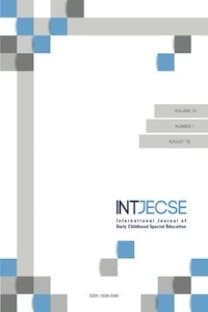The Effects of Incidental Teaching on Teaching Children with Autism Spectrum Disorders to Demand Their Lost Objects Verbally
Autism Spectrum Disorders, Incidental Teaching; Applied Behavior Analysis; verbally demanding skills; Otizm spektrum bozukluğu; konuşma; fırsat öğretimi; uygulamalı davranış analizi; iletişim becerileri
___
Amerikan Psikiyatri Birliği (2015). Mental Bozuklukların Tanısal ve Sayımsal Elkitabı, Beşinci Baskı (DSM-V), Amerikan Psikiyatri Birliği, Washington DC, 2013’ten çeviren Köroğlu E, Hekimler Yayın Birliği, Ankara.Baer, D.M., Wolf, M.M., & Risley, T.R. (1968). Some Current Dimensions of Applied Behavior Analysis, 1, 91-97.
Baer, D.M., Wolf, M.M., & Risley, T.R. (1987). Some Still-Current Dimensions of Applied Behavior Analysis. Journal of Applied Behavior Analysis. 20, 313-27
Birkan, B. (2011). Otizmli çocuklara konuşma becerilerinin öğretimi: Replikli öğretimi, Ankara Üniversitesi Eğitim Bilimleri Fakültesi Özel Eğitim Dergisi, 12(1), 57-69.
Birkan, B. (2009). Genel Eğitim Okullarında Özel Gereksinimli Olan Öğrenciler ve Özel Eğitim. Editör: Akçamete, G. A., Ankara: Kök Yayıncılık.
Charlop-Christy, H.M. ve Carpenter, H.M. (2000). Modified Incidental Teaching Sessions: A Procedures For Parents To Increase Spontaneous Speech In Their Children With Autism. Journal of Positive Behavior Internettions, 2, 2, 98-112.
Cowan, J. R ve Allen, D. K. (2007). Using Naturalistic Procedures To Enahance Learning In Individuals With Autism: A Focus On Generalized Teaching Within The School Setting. Psychology In The Schools, 44, (7).
Darıca, N., Abidoğlu, Ü., ve Gümüşçü, Ş. (2000). Otizm ve Otistik Çocuklar.
Farmer-Dougan, V. (1994). Increasing Requests By Adults With Developmental Disabilities Using Incidental Teaching By Peers. Journal Of Applied Behavior Analysis, 27(3), 533-544.
Hall, L.J., (2002). Autism Spectrum Disorders, Pearson.
Hart, B., ve Risley, T. R. (1968). Establishing use of descriptive adjectives in the spontaneous speech of disadvantaged preschool children. Journal of Applied Behavior Analysis, 1, 109-120.
Kroegel, K. A. ve Nelson, W. M. (2006). A Language Programme to İncrease the Verbal Production of a Chıld Dually Dıagnosed With Down Syndrome and Autism. Journal of Intellectual Disability Research, 50, 101- 108.
McGee, G., Krantz , P.J. , LYNN, A., McClahannahan, L.E. (1986). An Extension Of Incidental Teaching Procedures To Reading Instruction For Autistic Children. Journal of Applied Behavior Analysis. Sayi.19. No.2. 147-157.
McGee, G., Krantz, P.J ve McClannahan, L.E. (1985). The Facilitative Effects Of Incidental Teaching On Preposition Use By Autistic Children. Journal of Applied Behavior Analysis. Sayı.15. No.1. 17-31.
McGee, G., ve Daly, T. (2007). Incidental Teaching of Age-Appropriate Social Phrases to Children With Autism. Research & Practice for Persons with Severe Disabilities, 12 (2), 112-123. Emory Üniversitesi.
McGee, G.G., Krantz, P.J., Mason, D. ve McClannahan, L.E. (1983). A modified incidental-teaching procedure for autistic youth: acquisition and generalization of receptive object labels. Journal of Applied Behavior Analysis, 16 (.3), 329-338.
Milli Eğitim Bakanlığı, Özel Eğitim Rehberlik ve Danışma Hizmetleri Genel Müdürlüğü. (2002). "Otistik Çocukların Eğitiminde Aile El Kitabı", Milli Eğitim Basımevi, Ankara.
Mirenda, D., Light, J.C., & Schlosser, R.W. (1998). Thelmpact Of Agumentative and Alternative Communication Intervention On The Speech Production of Individuals With Autism. Journal of Positive Behavior Interventions., 53 (3).
National Research Council (2001). Educating Children with Autism. Washington DC: National Academy Press.
National Autism Center (2015). Findings and Conclusions: National Standards Phase 2. Randolph, MA: Author.
Oswald, Lowell K., Lignugaris, Benjamin W. ( 1990). The Effects of Incidental Teaching on The Generalized Use of Socials Amenities at School by A Mildly Handicapped Adolescent . Education & Treatment of Children,13(2).
Schepis, M.M., Reid, H.D., Fitzgerald, R. J., Faw, D. G., Pol, D.V.A. ve Welty, A.P.(1982). A Programme For Increasing Manual Signing By Autistic And Profoundly Retarded Youth Within The Daily Environment. Journal Of Applied Behavior Analysis, 15 (3), 363-379.
Siegel, B. (1996). The Word of the Autistic Child: Understanding and Treating Autistic Spectrum Disorders. Oxford UP. Evans Road.
Turan, A., (2003). Sevgi Dili Konuşan Çocuklar, İstanbul: Sistem Yayıncılık.
Topbaş, S. ( 2005). Dil ve Kavram Gelişimi. Ankara: Kök Yayıncılık.
- ISSN: 1308-5581
- Başlangıç: 2009
- Yayıncı: İbrahim H. DİKEN
Meram Mısır HORASAN, Binyamin Birkan
Exploring Efficacy of a Community-Based Reading Programme for At-Risk ChildrenJanet Siew Poh LAW
Janet Siew Poh LAW, Noel Kok Hwee CHIA
Special Educational Needs and Support Provisions in Swedish Preschools: A Multiple-Case Study
Lundqvist Johanna, Allodi Westing MARA, Siljehag Eva
Serhat Odluyurt, Hatice Deniz DEGİRMENCİ, Iclal Adalioglu, Alper Kapan
Cem Aslan, Selda ÖZDEMİR, Pinar DEMİRYUREK, Hale COTUK
Ayşe Tuba Ceyhun, Selda ÖZDEMİR, Gökhan TÖRET, Ufuk Özkubat
